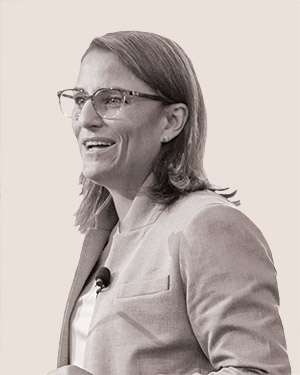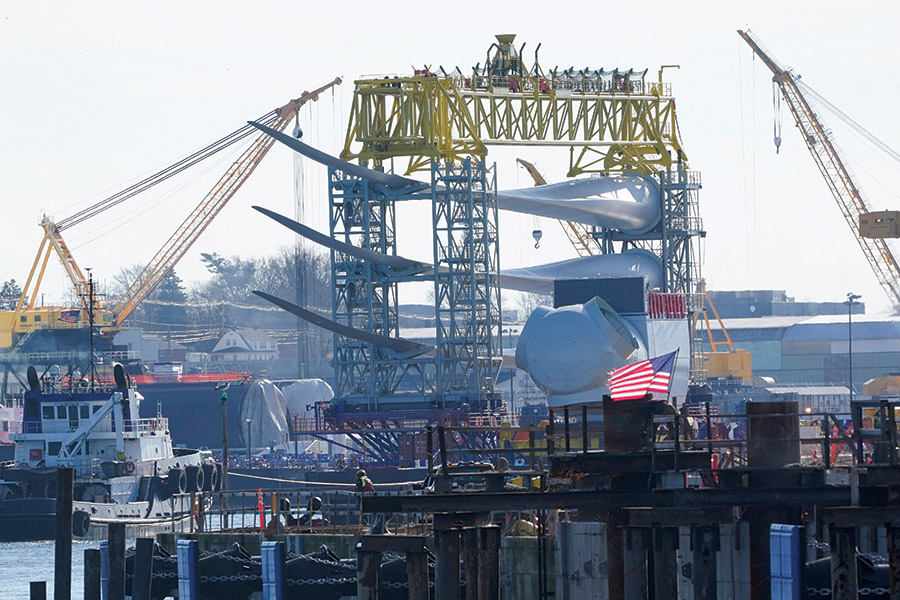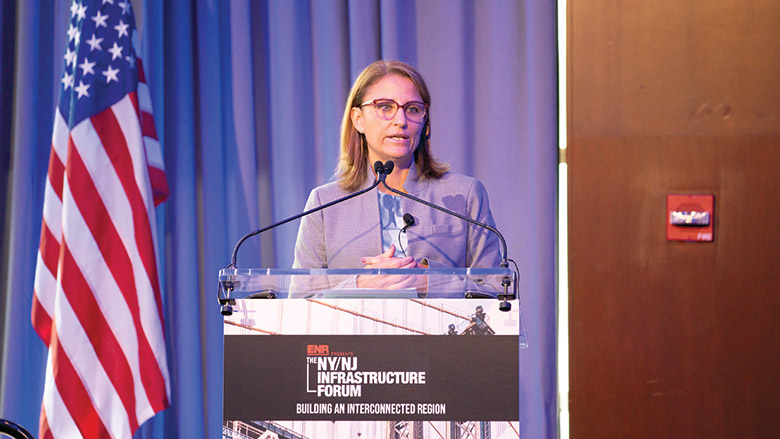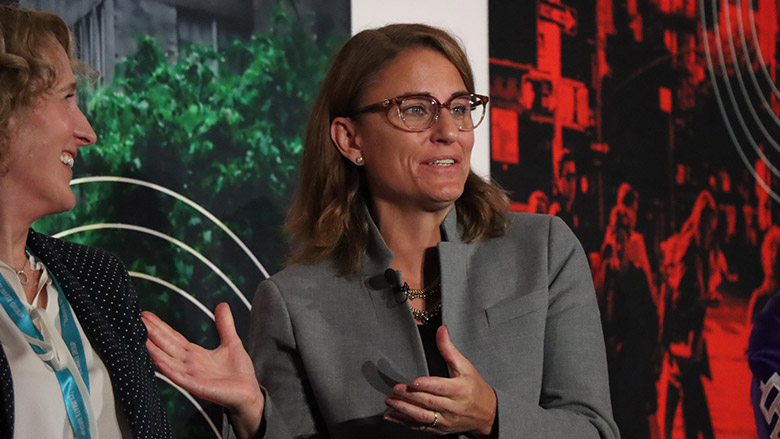
Related Article:
NY-NJ Industry Leaders See Reward, Risk in Transformational Infrastructure
Back to:
25 Top Newsmakers
Even as she leads New York state’s push to reach nation-leading goals in clean energy deployment— 70% renewables by 2030, a 100% zero-emission power grid by 2040 and greenhouse gas emissions cut by at least 85% from 1990 levels by 2050—Doreen M. Harris, president and CEO of the New York State Energy Research and Development Authority, acknowledges it's a “heavy lift” amid new market realities.
Harris’ efforts already were ramping up as the degreed engineer and 14-year NYSERDA veteran assumed its helm in 2020.
"My enthusiasm for engineering led me to NYSERDA and its large-scale renewables program," she says. "With every challenge is an opportunity that leads to a solution – especially as we face climate change – and this is what is most compelling for me."
The mission has more recently coincided with upheavals in the nascent clean energy construction sector caused by both political and financial forces that have challenged project development and are only now abating.
Despite the headwinds, the state has programs underway to develop billions of dollars of new clean energy infrastructure and expanded transmission to meet mandates of its climate law, which took effect in 2020, as well as growing power demand.
Last year, New York made it possible for America to finally join other nations in having power generated for the first time from a utility-scale offshore wind energy facility.
That U.S. clean power milestone was reached last December when the 132-MW South Fork project, 135 miles east of Montauk, successfully sent its first power to the state grid. New York has a goal of 9 GW of offshore wind energy by 2035.

The 132-MW South Fork offshore wind project being built off the coast of Long Island, NY, in December became the first U.S. utility-scale project to send power to the grid. Turbine component assembly is seen here at the State Pier in New London, Conn.
Photo: AP Photo/Seth Wenig
On Jan. 25, developer Orsted, which is developing the 12-turbine project with utility Eversource, said it "is set to reach full operations in the weeks ahead." South Fork did so in mid-March.
Project milestones also include installation of a 1,500-ton offshore substation fabricated by Kiewit in its Texas yard—the first to be made in the U.S.—and a 68-mile high-voltage alternating current export cable that is the first to be domestically manufactured.
The 806-MW Vineyard Wind offshore wind project in Massachusetts in early 2024 also announced its first power and aims to complete installation of its 62 turbines this year.
Taking Action
Even so, supply chain issues remain in the sector with other delayed or cancelled projects in New York and elsewhere in East Coast states, resulting from contract prices set in an early market stage that can’t cover building costs that have risen more recently.
Harris describes them as “significant and unforeseen by the industry.”
After New York regulators last year would not allow power price adjustments to ensure generating capacity, she was instrumental in fast-tracking a new offshore wind procurement round that would allow older projects to rebid.
“Looking to 2024, NYSERDA will continue with urgency to procure and advance large-scale renewable energy projects in support of New York’s 10-Point Action Plan while building a [state-based] supply chain,” she says, adding that awards for offshore wind and Tier 1 renewables projects stemming from expedited solicitations are expected in February and April, respectively.
The accelerated bid process included industry and stakeholder feedback based on previous renewable energy procurement rounds to incorporate inflation indexing, stakeholder engagement requirements, disadvantaged community commitments and labor provisions, Harris says.
NYSERDA also has streamlined the process "by selectively removing certain bid requirements that historically required substantial efforts to develop but provided nominal value in bid evaluations,” she adds. “Feedback will further inform how to ensure bids consider and balance long-term project viability, permitting timelines, market demand, development costs and risks, and opportunities that best advance the offshore wind supply chain while creating value for New York.”
Orsted announced on Jan. 25 that it resubmitted its bid in the new state solicitation for the 924-MW Sunrise Wind project, "which, if awarded, would improve the project’s financial position and advance the most mature offshore wind project in the state’s pipeline," it said. The firm also said it has acquired the Eversource share of the project and would be sole owner, it the bid wins.
Developer Equinor also said on Jan. 25 that it resubmitted a bid for the 810-MW Empire 1 project but cancelled its existing state power contract for the 1.2-GW Empire 2. The firm had been developing the projects with energy giant BP but also announced a split in the firms' partnership, which also includes joint ownership of the Beacon 1 and 2 wind projects, previously awarded. The four projects, which total about 4.4 GW, are set to be divided between the companies, with other land-based assets, when the deal closes later this year, Equinor said. The companies indicated they would continue to be active in U.S. offshore wind development.
Equinor said the split would result in an estimated loss of about $200 million, "assuming a positive outcome" of the New York solicitation, but that "will not impact" adjusted earnings.
“Empire Wind 1 is ready and so is Equinor,” said Molly Morris, president of Equinor Renewables Americas in a statement. “New York has demonstrated its commitment to offshore wind and this project will play a foundational role in driving that commitment forward."
The state is investing $700 million in offshore wind support infrastructure while working with other states and federal agencies “to collaborate and reduce costs through a shared vision for a U.S. supply chain,” Harris says. It also is pressing the U.S. government "for updated guidance on clean energy tax credits and a federal-state revenue sharing program" to ease project financial burdens, she adds.
“This reflects that we are not living in a world that is a very straight line,” Harris says. “It’s important for all of us not to be blindly optimistic about how we get from here to there.”
Billy Haugland, CEO of South Fork contractor Haugland Group, says “her bold leadership and vision will continue to produce innovative solutions.”

Doreen Harris, an engineer, has served as president and CEO of the New York State Energy Research and Development Authority since 2020.
Photo by Kristen Blush for ENR
The broader U.S. offshore wind sector also is noticing.
Under Harris, NYSERDA has been at the center of its supply chain and financial maelstrom, "taking decisive action to keep the industry on track,” says Liz Burdock, CEO of U.S.-based offshore wind advocacy group Oceantic Network, noting that her efforts “have sustained confidence” in both state and national sector progress.
Harris also has cited expanded transmission construction in New York as the “unsung hero” to cut emissions, calling the boosted state investment “truly historic” as its largest in 50 years. Projects include the 340-mile Champlain Hudson Power Express to carry high-voltage hydropower from Canada to New York City. Crews now work at 15 sites on the privately funded project, which is estimated to cost more than $6 billion.
The NYSERDA chief also points to 2 GW of community solar installed in New York, “reaffirming [the state] position as the top community solar market” in the U.S., she says, also noting “a record number of clean energy jobs in the state—now at 165,000 and growing.”
Looking ahead to the state’s ability to balance climate resilience and energy cost, she says: “We recognize our goals become less achievable or sustainable if investors are wary, developers can’t afford to undertake the projects and customers can’t afford their energy bills.”
ENR 2023 Top 25 Newsmakers will be recognized at the Award of Excellence Gala on April 11 in New York City.





